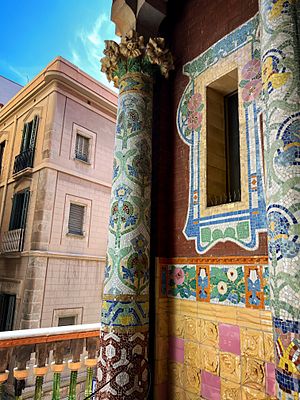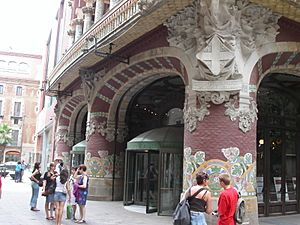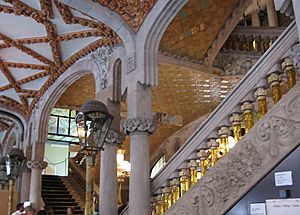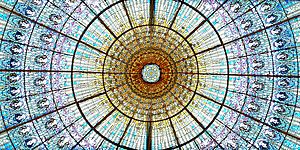Palau de la Música Catalana facts for kids
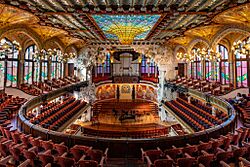
The Palau de la Música Catalana in 2019
|
|
| Location | Barcelona, Spain |
|---|---|
| Coordinates | 41°23′15″N 2°10′32″E / 41.38750°N 2.17556°E |
| Type | Concert hall |
| Construction | |
| Built | 1905–1908 |
| Opened | 9 February 1908 |
| Architect | Lluís Domènech i Montaner |
| UNESCO World Heritage Site | |
| Part of | Palau de la Música Catalana and Hospital de Sant Pau, Barcelona |
| Criteria | Cultural: i, ii, iv |
| Inscription | 1997 (21st Session) |
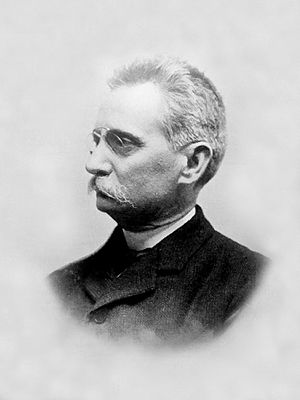
The Palau de la Música Catalana (which means "Palace of Catalan Music" in English) is a famous concert hall in Barcelona, Catalonia, Spain. It was designed in a special style called Catalan modernisme by the architect Lluís Domènech i Montaner. The building was constructed between 1905 and 1908 for the Orfeó Català, a singing group founded in 1891. This group was very important in a cultural movement known as the Renaixença (Catalan Rebirth). The Palau officially opened on February 9, 1908.
The Orfeó Català mainly paid for the building, but rich business people from Barcelona also helped a lot. In 1909, the architect won an award from the Barcelona City Council for designing the best building of the previous year. From 1982 to 1989, the building was carefully restored and made bigger by architects Oscar Tusquets and Carles Díaz. In 1997, the Palau de la Música Catalana became a UNESCO World Heritage Site, along with the Hospital de Sant Pau. Today, over half a million people visit the Palau each year to enjoy many types of music, from classical to jazz and Catalan songs.
Contents
The Architect
The Palau de la Música Catalana was designed by Lluís Domènech i Montaner. He was a well-known Catalan architect and also a politician. Born in Barcelona in December 1850, he first studied science in Madrid. He finished his architecture studies in 1873 at the University of Barcelona. For 45 years, he taught and led the school of architecture in Barcelona. His designs were part of the Art Nouveau movement. They often included beautiful decorations like mosaics and stained glass.
The Building
Location
The Palau is located on a narrow street corner in the old part of Barcelona, called Casc Antic. Many other famous modernista buildings, like those by Antoni Gaudí, are in a newer, more fashionable part of the city called the Eixample.
Design
The design of the Palau shows the typical style of Catalan modernism. It uses many curves instead of straight lines. It also prefers lively shapes over plain ones. The building is richly decorated with flowers and other natural designs.
Even with all its decoration, the Palau's design is very smart. It was built to work well as a concert hall. It also used the newest materials and building methods from the early 1900s, like steel frames. Its walls were some of the first examples of "curtain walls." These are outer walls that don't support the roof, allowing for more glass and openness.
The wealthy people of Barcelona, who supported the Renaixença movement, wanted the building to show Catalan culture. So, the architect hired many local artists and craftspeople. They created the amazing decorations, sculptures, and colorful parts that make the Palau so famous.
Façade
The outside of the Palau is very richly decorated. It mixes ideas from traditional Spanish and Arabic architecture. This decoration fits perfectly with the building's structure. The red brick, iron, mosaics, stained glass, and shiny tiles were chosen to make the building look open and bright.
Even the large sculpture by Miguel Blay on the corner, which represents Catalan music, doesn't block the view. You can still see into and out of the building easily. It's like the building is not a closed-off space, but an open and welcoming one.
On the second-floor balcony, there are two rows of columns. Each column is uniquely covered with colorful glazed tiles, mostly with flower patterns. At night, lamps on top of these columns light up brightly. Above the columns, you can see large busts (head and shoulders sculptures) of famous composers: Giovanni Pierluigi da Palestrina, Johann Sebastian Bach, and Ludwig van Beethoven on the front. Richard Wagner is on the side. The very top of the main front has a large mosaic by Lluís Bru. It shows the members of the Orfeó Català, but it's hard to see clearly from the narrow street below.
Entrance
In the past, visitors entered the Palau through two arches supported by thick pillars. These arches led into the main entrance area, called the vestibule. The old ticket windows, located in the middle pillar, are beautiful. They have many arches decorated with colorful flower mosaics made by Lluís Bru.
Vestibule, Staircases, and Foyer
The ceiling of the vestibule has shiny ceramic decorations shaped like stars. From here, grand marble staircases go up to the second floor on both the left and right. The stair railings are also marble and are held up by unusual clear yellow glass posts. The underside of the staircases is covered with tiles that look like shining canopies.
Today, most visitors enter through the foyer. This area was created during the renovations by Tusquets and Díaz. It used to be the main office for the Orfeó Català. The foyer is simpler than the rest of the palace, but it still has beautiful details. Wide brick arches are decorated with amazing glazed green, pink, and yellow ceramic flowers, matching the rest of the building. The foyer has a large counter where snacks and drinks are served. This bar is between huge brick pillars and is lit from behind by large stained-glass windows. A glass case in the foyer displays the Orfeó Català's special banner, which has its symbol embroidered in the modernisme style.
Lluís Millet Hall
The Lluís Millet hall is a special room on the second floor. It is named after one of the people who started the Orfeó Català. This hall is a popular place for people to gather before concerts. It's also used for tours of the building. The hall is two stories high. From its windows, you can get a much better view of the detailed mosaics on the columns outside than you can from the street.
The hall is decorated with several bronze busts (sculptures of heads and shoulders) of musicians connected to the Palau. These include Lluís Millet and Amadeu Vives (who founded Orfeó Català), Pablo Casals, Eduard Toldrà (who started the Barcelona Municipal Orchestra), Just Cabot (a president of Orfeó Català), and pianist Rosa Sabater.
Concert Hall
The concert hall inside the Palau is truly special. It can seat about 2,200 people. It is the only concert hall in Europe that gets all its light from natural daylight. The walls on two sides are mostly made of beautiful stained-glass windows set in grand arches. Above, there is a huge stained-glass skylight designed by Antoni Rigalt. Its center is an upside-down dome in gold and blue, looking like the sun and sky.
The decorations in the concert hall are incredibly creative. Everything was carefully planned to help the music sound its best. The hall is not a typical theater because large sculptures on the stage make it hard to use scenery. Also, even though there's a grand pipe organ above the stage, it's not a church.
The main theme of the rich sculptures in the concert hall is choral music. This makes sense, as a singing group built the hall. A choir of young women surrounds the "sun" in the stained-glass skylight. A bust of Josep Anselm Clavé, a famous choir director who helped bring back Catalan folk songs, is on the left side of the stage. Under his statue are sculpted girls singing a Catalan song called Les Flors de Maig (The Flowers of May).
The large arch over the front of the stage was sculpted by Dídac Masana and Pablo Gargallo. On the right side, it shows the 'Ride of the Valkyries' from Wagner's opera Die Walküre. Below the Valkyries, among two Doric columns, is a bust of Beethoven. So, the arch shows folk music on the left and classical music on the right, both joining at the top.
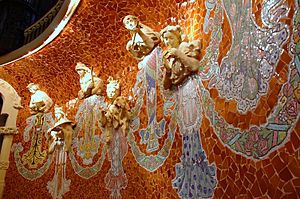
Around the back of the stage, in a half-circle, are 18 figures of young women known as the 'muses'. Their upper bodies were sculpted by Eusebi Arnau. The mosaic work for their lower bodies was created by Lluís Bru. The muses' upper bodies stick out from the wall, while their lower bodies are colorful mosaics that are part of the wall. Each muse plays a different musical instrument and wears a unique, fancy outfit. In the middle of the two groups of muses is a mosaic of the coat of arms of Catalonia. One muse, to the right of the Catalan coat of arms, has the coat of arms of Austria and a double-headed eagle (symbols of the Spanish Habsburgs royal family) on her dress.
Sculptures of winged horses are placed high up on the balcony. These honor Pegasus, the horse from Greek mythology who represents high-flying imagination.
In the spaces between the pillars and glass walls, there are white tile medallions. These are bordered with green laurel leaves and have the names of famous musicians. To the left of the stage, you can find: Palestrina, J. S. Bach, Carissimi, Beethoven, and Chopin. To the right: Victoria, Handel, Mozart, Gluck, and Richard Wagner. On a wall higher up, there are four more ceramic medallions. These tell the story of Catalan music with names like Joan Brudieu, Mateu Fletxa el Vell, Anselm Viola i Valentí, Domènec Terradellas, and Josep Anselm Clavé.
Some people have noted that the glass walls, while beautiful, can affect the sound in the hall.
Remodeling and Expansion
Between 1982 and 1989, parts of the building were brought back to their original look. They were also updated with new technology and made bigger for more uses. The new work was done carefully so it didn't change the original beauty or structure of the building. Stone, brick, iron, glass, and ceramics were used in the same way the original architect, Domènech i Montaner, used them. One important addition was a new six-story building next door. It holds dressing rooms, a library, and an archive.
From 2006 to 2008, more restoration work was done. The lantern on top of the corner tower was put back. Some other decorative parts of the outside were also fixed.
Petit Palau
The Petit Palau (meaning "small palace") opened in 2004. It is located 11 meters below the ground, under a square that was created during the 1982-1989 renovations. This smaller hall can seat 538 people. It has special features that allow the sound to be changed for different types of music or spoken events. It also has the latest audio and video technology. Like the other new parts, it was designed to match the style of Domènech i Montaner. It is bright and open, like the main Palau, but also very modern and flexible for many cultural, social, and business events.
Appearances in Film
On September 7, 2018, the Palau appeared in a TV trailer for Season 11 of Doctor Who. The trailer showed Jodie Whittaker, as the first female Doctor, appearing to 'shatter the glass ceiling' of the Palau's amazing skylight.
Artistic History
Since the Palau opened in 1908, it has focused on promoting local composers and artists. After World War I, the Orquestra Pau Casals performed there. From 1921 onwards, they featured music by composers like Enrique Granados. Many famous soloists and singers, including Pablo Casals and Alicia de Larrocha, have performed at the Palau.
Important Premieres
As a major concert hall in Barcelona, the Palau has hosted the very first performances (premieres) of many musical works. Here are a few examples:
- In 1908, Enric Granados' symphonic poem Dante was first performed.
- In 1911, Enric Granados' piano suite Goyescas (first book) and other works had their premieres.
- In 1940, Joaquín Rodrigo's famous Concierto de Aranjuez was first played here.
- In 1945, Xavier Montsalvatge's Cinco canciones negras had its first performance.
- In 1957, Salvador Espriu's play Primera història d'Esther premiered.
- In 1961, Frederic Mompou's Variacions sobre un tema de Chopin for orchestra was first heard.
See also
 In Spanish: Palacio de la Música Catalana para niños
In Spanish: Palacio de la Música Catalana para niños
- List of theatres and concert halls in Barcelona
- List of Modernista buildings in Barcelona
- List of concert halls




